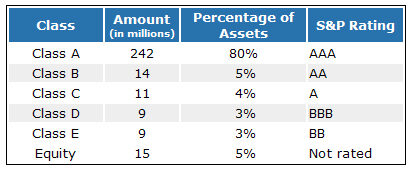What is a Collateralized Debt Obligation (CDO)?
A collateralized debt obligation (CDO) is a security that repackages individual fixed-income assets into a product that can be chopped into pieces and then sold on the secondary market. They are called collateralized because the assets being packaged -- mortgages, corporate debt, auto loans or credit card debt- - serve as collateral for investors.
How Does a Collateralized Debt Obligation (CDO) Work?
CDOs are described as structured asset-backed securities because they pay cash flows to investors in a prescribed sequence, based on how much cash flow is collected from the package of assets owned.
The CDO is split into different risk classes known as tranches. Interest and principal payments are made in order of seniority so that senior tranches have the least risk. Junior tranches, which have higher default risk, usually have higher coupon payments.
A typical CDO may consist of a portfolio of 100 corporate bonds and have an average S&P rating of B+. Assuming a total portfolio size of $300 million, the CDO might have six classes or tranches:

The Class A senior tranche will offer investors the lowest yield since it has the highest S&P rating. The equity tranche would have the highest yield since it is the most risky component of the deal structure.
Why Does a Collateralized Debt Obligation (CDO) Matter?
Collateralized debt obligations allow banks and corporations to sell off debt and free up capital to re-invest or loan. The downside of CDOs is that the loan originators have little incentive to collect when loans in the package come due since these loans are now owned by other investors. This may make originators less disciplined in adhering to strict lending standards.
Another downside of CDOs is the complexity of these products. Buyers may not know exactly what they are buying or whether the package is really worth the price. The opaqueness and complexity of CDOs can result in a market panic if investors lose confidence and CDOs become more difficult to re-sell. This was the scenario during the Sub-Prime Crisis of 2007 when many banks were forced to take sizable write-downs on their CDO holdings.



